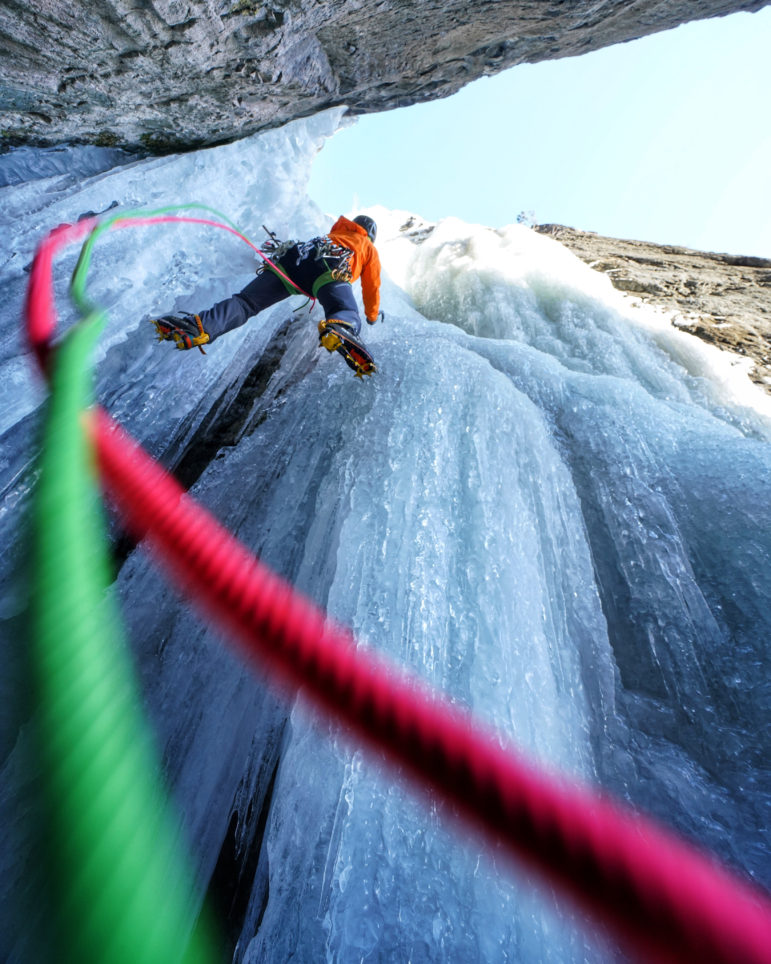
Red and green climbing ropes hang down from Dane Steadman as he climbs Too Cold To Fire, a frozen waterfall in the South Fork Valley near Cody, Wyo., prior to the Wyoming Ice Festival. (Courtesy photo from Aaron Mulkey)
CODY, Wyo. — Dozens of adventurers gathered here over the weekend to strap sharp metal blades to their feet and grip long, pointed axes in each hand before venturing into the Shoshone National Forest in pursuit of their dangerous and elusive prey: frozen waterfalls.
Ice climbers from across the country attended the inaugural Wyoming Ice Festival, a four-day event offering clinics, gear demonstrations, a film screening and social gatherings for enthusiasts eager to climb some of the most challenging ice in the country.
Less than an hour’s drive southwest of Cody, ice climbers converge each winter in the South Fork Valley to scale literal frozen waterfalls. Some are freestanding columns of ice—gargantuan icicles the size of grain silos—unconnected to anything but the ground below and a cliff edge above. Others are towering, multi-leveled cascades of seemingly endless ice, stair-stepping high into the winter clouds overhead.
With roots in mountaineering, and similar to rock climbing, ice climbing uses specialized gear like ice axes and spiked boot attachments called crampons. The Cody area is home to the largest concentration of challenging climbing routes in the U.S. outside of Alaska, aficionados say.
Now in his mid-40s, festival organizer Aaron Mulkey moved to Cody from Boulder, Colo. in his early 20s, specifically because there were so many challenging ice routes.
His goal is to grow the festival into a major annual event that will showcase the region’s amazing climbs, and help the local winter tourism economy when business is slowest. Mulkey took over the long-running festival and relaunched it this year with new branding after a hiatus under previous ownership due to the pandemic and other factors.
“This year, we’re keeping it small and simple with the goal of focusing on safety,” he said. “We have group clinics run by certified guides at really safe spots where we don’t have to worry about avalanches or rocks falling.”
Nearly all clinic spots were booked before the festival began, Mulkey said, and a number of big-name sponsors like Black Diamond outdoor gear and Ford Bronco were backing the event. The festival drew approximately 125 attendees, he said.
Attendee Chris Boyle traveled from Bend, Ore. to climb Cody ice for the first time. He arrived early and joined a friend for a few ascents before the festival started.
“The geology here is so different than anywhere else,” Boyle said. “It’s just amazing climbing.”
Eric Henderson traveled from Des Moines, Iowa to climb here for the first time. He was planning a trip to Cody later this year with friends, but chose at the last minute to join the festival.
“I decided to just pull the trigger and come here and sign up for some clinics,” he said. “I had heard it was such a big, wild area. I figured that way I could get a good grounding and base for future trips, doing the clinics and talking to locals.”
Henderson said he also came to make connections, because he doesn’t know any other ice climbers in his hometown.
“It’s a specialized sport, it’s difficult and it’s cold,” he said. “And let’s face it, you’re basically strapping sharp knives to your hands and feet, so it can be scary for some people.”
Climbs for experts and beginners
Cody’s reputation for big, challenging, technical ice has made it a haven for experienced climbers, said Chris Guyer, a festival volunteer who moved to Cody from Billings, Mont. because of the big ice.
“Everything here is bigger. The approaches are bigger, and you have a unique feeling of having a private adventure in the wilderness. There’s a real mystique,” Guyer said, using a word other climbers repeated when describing Cody ice.
“The South Fork is so big, so vast, that there might be five other parties climbing out there on a given weekend, but you’d never know it,” he said. And after 15 years of climbing the valley, Guyer said he still finds new and challenging routes.
But because just the approaches—hikes from main roads to the bottoms of the ice columns—can be a major challenge for beginners, Mulkey and other local climbers are looking to create a novice-friendly ice park just minutes from downtown Cody.
A few Rocky Mountain towns use sprinklers and other artificial means to “farm” ice into safer, more approachable formations, providing first-timers a tailor-made experience that’s easier and more convenient than the big ice in wild, remote locations.
Ice parks are analogous to how climbing gyms have made rock climbing more accessible, Mulkey said, and towns are developing them as a low-cost, low-impact tourist draw.
Creating an ice park in a spot like the Shoshone Canyon, between Cody and the Buffalo Bill Dam, would let climbers drive 10 minutes from the airport or a hotel and start an approachable climb after a 15-minute walk, he said.
Cody Mayor Matt Hall said he has had discussions with local ice climbers about creating an ice park, “but it has never gone past the brainstorming stage.”
“But obviously, something like that would take this event from great to the next level,” Hall said, “and I’m happy to consider the idea and see how the town could get behind it.”
Hall, an experienced rock climber who has yet to strap on ice climbing gear, said he was “excited and grateful to see all the local climbers working to make this a great event.”
Reprinted with permission from the Wyoming Truth.
